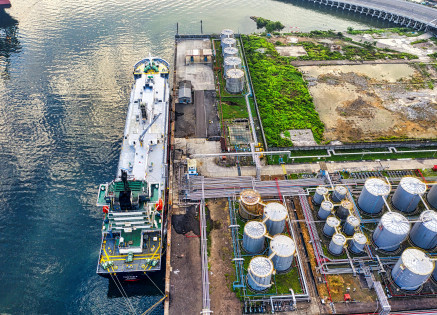Copyright © 2025 lmitac.com All Rights Reserved. Contact - Terms and Conditions - Privacy Policy - Quality Policy - Become an instructor - Vacancies - Sitemap
London Maritime Academy is a trade name for London Premier Groupversion: 2.9.0
London Maritime Academy is a trade name for London Premier Group

Posted on : 9/17/2024, 8:13:15 PM
Ballast tanks play a crucial role in the shipping industry, but have you ever wondered what exactly they do? These specialised compartments are essential for maintaining a ship's stability and ensuring safe navigation over the vast oceans.
In this guide, we will explore what ballast tanks are, how they function, their importance in maritime operations, and the environmental considerations surrounding them.
In simple terms, a ballast tank is a compartment within a ship designed to carry water or other ballast materials to stabilise the vessel while floating, improve buoyancy, and hold vessels at level in seawater. When a ship is sailing, its weight distribution can be affected by cargo loads, fuel consumption, and other operational changes. Ballast tanks ensure the ship or boat maintains its centre of gravity, preventing capsizing and ensuring smooth sailing.
The design and application of ballast tanks varies depending on the type of vessel and its specific needs. Some ships have dedicated spaces located in the centre of ships completely separated from hulls, while others may use space within existing cargo holds. They can be filled with water (either from the sea or freshwater sources) depending on the operational requirements, to allow a safe transfer process.
Ballast tanks are an important part of Shipping management courses online, that’s why understanding how they work is crucial.
Ballast tanks are primarily used in boats and submarines for two main purposes: ensuring stability and maintaining trim. Stability is the ability of a ship to return to an upright position after being tilted by waves or air. Trim refers to the orientation of the ship in the water; balanced trim minimises drag and improves fuel efficiency.
To achieve optimal stability and protect the balance of the ship during its voyage, ballast tanks can be filled or emptied as needed. For instance, when a ship is loading at pickup or is at max capacity, the ship will sink to a lower depth due to the heavy pressure, water can be pumped into the ballast tanks to counterbalance the hydrostatic weight of the hull. Conversely, when unloading cargo at a port or when the ship needs to rise higher in the water, water can be expelled from the tanks.
One other thing is: Ballast tanks are special in structure and usually have epoxy coating of light paint colours as a universal rule enforced by the IMO to facilitate inspection of any accidental corrosion to the body and provide protection and flexibility of maintenance.
Modern vessels often employ sophisticated systems for operating ballast tankers. Automated pumps and sensors provide precise control, enabling the ship to quickly adapt to all conditions (the increase and decrease of cargo). This adaptability is vital, especially in rough seas, where even slight changes in weight distribution can significantly impact a ship's performance.

The significance of ballast tanks cannot be overstated. They are essential not just for the structural integrity of a ship, but also for safety. Without adequate ballast, a ship may become top-heavy and prone to tipping, which could lead to catastrophic accidents.
Moreover, ballast tanks contribute to the overall efficiency of maritime operations. By allowing vessels to adjust their weight distribution, shipping companies can optimise fuel usage, minimise emissions, and improve economic viability. Well-managed ballast systems can reduce a vessel's drag, enhancing its speed and performance, which ultimately translates into cost savings.
With increasing awareness of environmental issues, the role of ballast tanks has come under scrutiny. When ships take on ballast fluid from one location and pump it in another, they can inadvertently introduce invasive species into new environments. This can disrupt local ecosystems and harm native creatures and organisms, permanently causing ecological life consequences.
As a solution, international regulations, such as the Ballast Water Management Convention, have been established to address these concerns. Ships are required to treat ballast water before discharge, using various methods such as filtration, UV treatment, or chemical processes. These measures are a stern yet excellent method to help ensure that only clean, non-invasive water is released, protecting biodiversity around the globe.
As the shipping industry progresses, innovations in shipping technology are becoming increasingly common. Innovative systems like ultrasonic treatments and electrolysis have emerged as promising solutions. For example, ultrasonic technology utilises high-frequency sound waves to eliminate harmful organisms effectively.
Additionally, eco-friendly designs are gaining traction, focusing on minimising the environmental impact of ballast water management. Some companies are exploring the use of smart technology to monitor and control ballast levels, ensuring that vessels can maintain optimal stability without compromising environmental standards.
In summary, ballast tanks are indispensable in the shipping industry, ensuring vessel stability, safety, and operational efficiency. As technology evolves and environmental regulations tighten, the management and innovation surrounding ballast systems will continue to develop. Understanding their role and significance is essential not just for maritime professionals but for anyone interested in the intricate workings of global shipping.